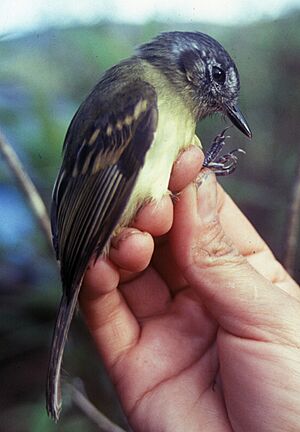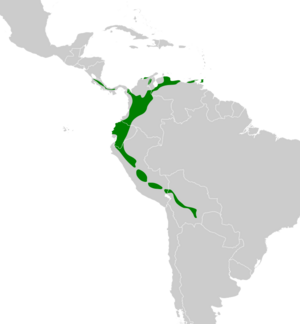Slaty-capped flycatcher facts for kids
Quick facts for kids Slaty-capped flycatcher |
|
|---|---|
 |
|
| Conservation status | |
| Scientific classification | |
| Genus: |
Leptopogon
|
| Species: |
superciliaris
|
 |
|
The slaty-capped flycatcher (Leptopogon superciliaris) is a small bird. It belongs to the tyrant flycatcher family. These birds are known for catching insects while flying. You can find them in many places, from northern Bolivia all the way to Costa Rica. They also live on the island of Trinidad.
Contents
What Does It Look Like?
The adult slaty-capped flycatcher is about 12.5 centimeters (5 inches) long. It weighs around 12 grams, which is about as much as a few paper clips!
Colors and Markings
This bird has a dark grey cap on its head. Its face is a mix of grey and white. It also has a grey stripe above its eye, called a supercilium. There's a black, curved patch near its ear.
Its back and upper parts are olive-green. Its wings are a bit dark and have two bright yellowish stripes. The throat is whitish. Its chest is greenish-yellow, fading to a bright yellow on its belly.
Beak and Young Birds
The slaty-capped flycatcher has a long, strong beak. The top part is black, and the bottom part is pink.
Both male and female birds look very similar. However, young birds have a more olive-colored cap. Their face patterns are not as strong. They also have orange wing stripes and lighter colors on their undersides.
Its Call
These birds have a sharp call that sounds like switch-choo.
Where Does It Live?
The slaty-capped flycatcher lives in many countries. You can find them breeding from Costa Rica through Colombia and northern Venezuela. They also live in northern Bolivia, Ecuador, and Peru. As mentioned, they are also found on the island of Trinidad.
Preferred Homes
These birds like to live in forests. They are often seen at the edges of woodlands. This gives them good places to hide and also open areas to hunt for food.
How It Behaves
Slaty-capped flycatchers are usually seen alone or in pairs. They often perch out in the open, watching for food.
What They Eat
They are very good at catching insects. They can grab insects right out of the air! They also pick insects from leaves. Besides insects, they enjoy eating berries.
Life Cycle and Nesting
When it's time to build a home, the slaty-capped flycatcher creates a special nest.
Building a Nest
The nest is shaped like a ball. It is lined inside with soft, fine plant fibers. It has an entrance on the side. These birds are clever about where they build their nests. They often hang them from a thin root or a climbing plant. They choose very shady spots, like inside a crack in a rock or under plants hanging over a bank.
Eggs
A female slaty-capped flycatcher usually lays two white eggs.


